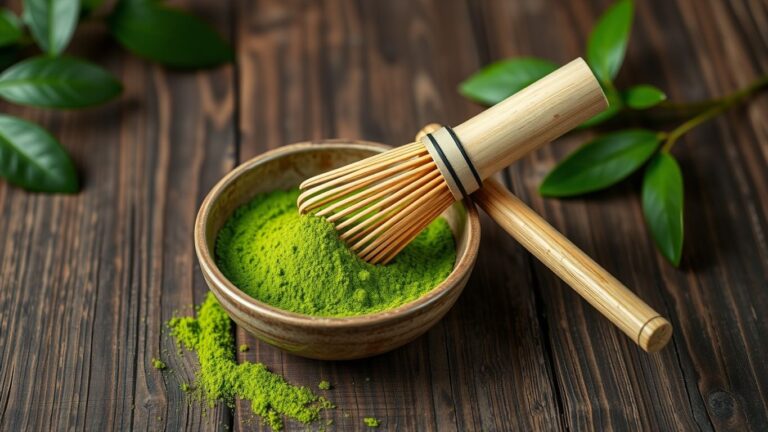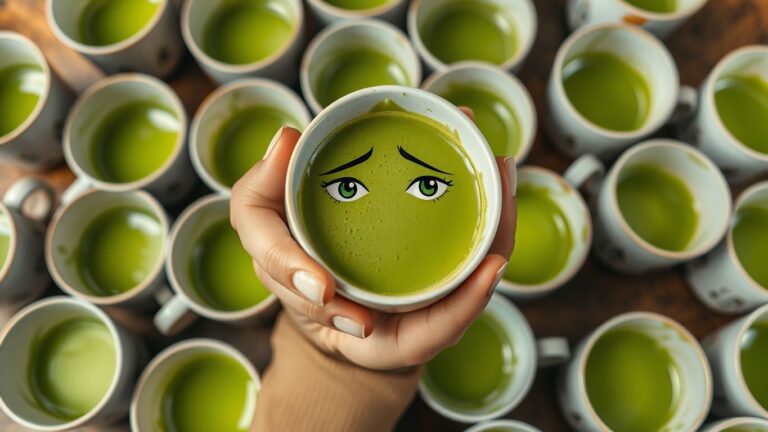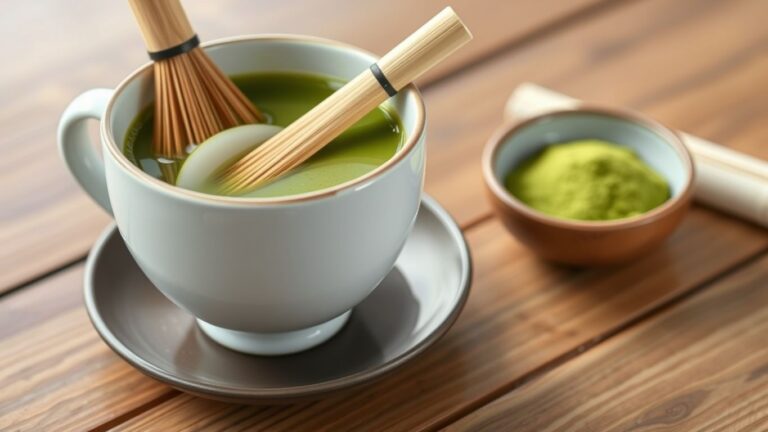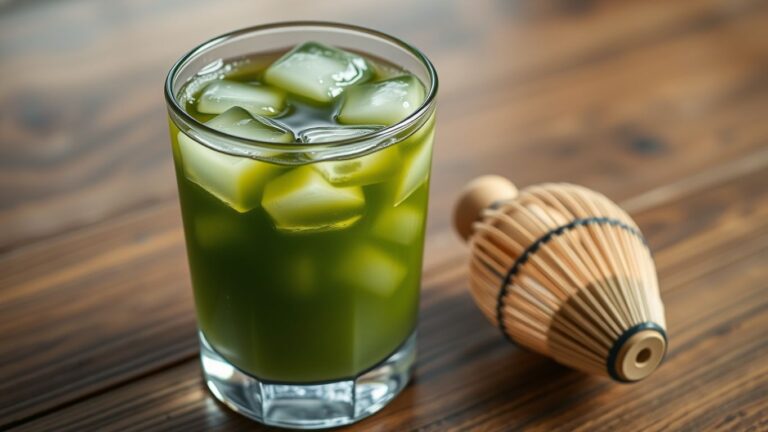Matcha powder is a popular choice for tea lovers and health enthusiasts alike. Known for its vibrant green color and unique flavor, matcha is made from finely ground green tea leaves. But how long does it last? Does it ever expire? And what can you do to keep it fresh for as long as possible? This article will dive into the shelf life of matcha powder, how to store it properly, and how to tell if it has gone bad.
Key Takeaways
- Matcha powder is best consumed within 1-2 months of opening for optimal flavor and health benefits.
- Proper storage is essential for maintaining the quality of matcha powder. Use an airtight container and keep it in a cool, dark place.
- Expired matcha powder is generally safe to consume but may have a bitter taste and less vibrant color.
- Signs that matcha powder has gone bad include changes in color, aroma, and texture.
- Refrigerating or freezing matcha powder can extend its shelf life, but it’s crucial to store it properly to avoid moisture and odors.
Understanding Matcha Powder Shelf Life
Factors Affecting Shelf Life
Several factors influence the shelf life of matcha powder:
- Oxidation: Exposure to air can cause matcha to lose its vibrant green color and freshness.
- Light: UV rays can speed up the breakdown of chlorophyll, leading to color changes.
- Moisture: Matcha easily absorbs moisture, which can cause clumping and reduce quality.
- Temperature: High temperatures can speed up the deterioration of matcha.
Typical Shelf Life of Matcha
Matcha powder is best enjoyed within 2-3 months after opening. While it can last up to 1-2 years if stored properly, its vibrant green hue and delicate flavors are at their peak shortly after opening.
How to Extend Shelf Life
To keep your matcha fresh for as long as possible, follow these tips:
- Store it in an airtight container to minimize exposure to air.
- Keep it in a cool, dark place away from direct sunlight and heat sources.
- Avoid exposing it to moisture by ensuring the container and environment are dry.
- Refrigerate it if you live in a warm and humid environment, but make sure the container is fully sealed to prevent it from absorbing unwanted odors.
Does Matcha Powder Expire?
What Expiration Dates Really Mean
Matcha powder, like many consumables, does have a shelf life. Most expiration dates listed on matcha containers range from one to two years. However, this doesn’t mean the matcha becomes unsafe after this period. Instead, it indicates the time frame during which the matcha is expected to maintain its best quality.
Changes in Quality Over Time
Over time, matcha powder can lose its vibrant green color and fresh flavor. The vibrant green hue and delicate flavors of matcha are best experienced within 2-3 months after opening. After this period, the matcha may start to taste more bitter and take on a yellowish, dull coloring. This change is due to oxidation and exposure to air, light, and moisture.
Is Expired Matcha Safe to Consume?
Technically, matcha does not "expire" in the sense that it becomes unsafe to consume. You can still safely consume matcha powder after its expiration date, but it might not taste as good. The health benefits may also diminish over time. If your matcha has lost its grassy, umami flavor, it might be best to use it in cooking or baking rather than drinking it as tea.
Remember, proper storage is key to maintaining the quality of your matcha. Always store it in an airtight container, away from direct sunlight, excessive heat, and humidity.
Signs Your Matcha Powder Has Gone Bad

Color Changes
One of the easiest ways to tell if your matcha powder is no longer fresh is by looking at its color. Fresh matcha is a vibrant green. If your matcha has turned dull or yellowish, it’s a sign of oxidation and quality loss. Lower grades of matcha, like culinary grade, may naturally have a duller shade, but any significant color change is a red flag.
Aroma and Flavor Shifts
Matcha should have a fresh, grassy aroma with a hint of sweetness. If the scent is faint or musty, it’s likely past its prime. When you taste it, fresh matcha has a balanced flavor, combining sweetness with umami. If it tastes overly bitter or stale, it’s time to replace it.
Texture and Clumping
Pay attention to the texture of your matcha. Fresh matcha should feel soft and fluffy. If it feels gritty or sand-like while sifting, it has likely deteriorated. Also, if you notice clumping, it could be a sign that moisture has gotten into the container, which can lead to mold.
Remember, even with proper storage, matcha can still degrade over time. Always check for these signs to ensure you’re consuming the freshest matcha possible.
Proper Storage Techniques for Matcha Powder
Choosing the Right Container
To keep your matcha fresh, always use an airtight container. This helps prevent exposure to air, which can cause the powder to lose its flavor and health benefits. Opt for opaque or dark containers to block out light, which can also degrade the quality of your matcha.
Ideal Storage Conditions
Store your matcha in a cool, dark place. Avoid areas with direct sunlight or high temperatures, as these can speed up the deterioration process. A pantry or a cabinet away from heat sources is ideal.
Common Storage Mistakes
- Using Transparent Containers: Light exposure can cause your matcha to lose its vibrant color and develop a metallic taste.
- Storing Near Heat Sources: Heat can quickly degrade the quality of your matcha.
- Not Sealing Properly: Always ensure your container is fully sealed to keep out air and moisture.
Storing matcha in a dark, airtight container helps preserve its beautiful green color and prevents that metallic taste that can develop from light exposure.
The Impact of Oxidation on Matcha Quality

What is Oxidation?
Oxidation is a chemical reaction that happens when matcha powder is exposed to air. This process can break down the beneficial compounds in matcha, leading to a loss of quality. The vibrant green color of matcha can fade, and its taste can become stale.
How Oxidation Affects Matcha
When matcha undergoes oxidation, several changes occur:
- Color: The bright green hue turns dull or brownish.
- Flavor: The fresh, grassy taste becomes flat and sometimes bitter.
- Nutrients: The levels of antioxidants, like EGCG, decrease significantly.
Preventing Oxidation
To keep your matcha fresh and vibrant, follow these tips:
- Airtight Containers: Store matcha in airtight containers to limit exposure to air.
- Cool and Dark Places: Keep matcha in a cool, dark place to slow down oxidation.
- Minimal Exposure: Open the container only when necessary and reseal it quickly.
Remember, matcha has significantly higher antioxidant levels compared to other green teas. Protecting it from oxidation helps maintain these benefits.
Refrigerating and Freezing Matcha Powder
When to Refrigerate Matcha
You can refrigerate matcha powder to keep it fresh for longer, especially if you live in a warm and humid environment. However, make sure the container is airtight to prevent the powder from absorbing unwanted smells and flavors. Refrigerate if necessary, but always check if the container is fully locked before returning it to the fridge.
Proper Freezing Techniques
Freezing matcha powder can extend its shelf life, but it’s best to freeze only unopened packages. Before opening, let the matcha thaw completely at room temperature to avoid exposing it to humidity. Freezing an already opened package is not recommended, as it can expose the tea powder to moisture, particularly when thawing.
Thawing and Using Frozen Matcha
When you’re ready to use frozen matcha, allow it to return to room temperature before opening the container. This prevents condensation from forming, which could make your matcha clumpy. Once thawed, use the matcha as you normally would, whether in tea, smoothies, or other recipes.
Keeping matcha in an air and light-proof container in the fridge will extend its shelf life up to 6 months. In areas with hot and humid climates, this is also an effective way to prevent mold from growing.
Comparing Ceremonial and Culinary Grade Matcha

When it comes to matcha, understanding the real difference between ceremonial and culinary grades is essential. Each type serves a unique purpose and offers distinct qualities that cater to different needs and preferences.
Shelf Life Differences
Ceremonial grade matcha is typically fresher and has a shorter shelf life compared to culinary grade matcha. This is because ceremonial matcha is made from the youngest tea leaves, which are more delicate and prone to oxidation. On the other hand, culinary grade matcha is made from older leaves, which are more robust and can last longer.
| Grade | Shelf Life (Unopened) | Shelf Life (Opened) |
|---|---|---|
| Ceremonial | 6-12 months | 1-2 months |
| Culinary | 12-18 months | 2-3 months |
Storage Recommendations
To maintain the quality of both ceremonial and culinary grade matcha, proper storage is crucial. Here are some tips:
- Airtight Containers: Always store matcha in airtight containers to prevent exposure to air and moisture.
- Cool and Dark Place: Keep your matcha in a cool, dark place, away from direct sunlight and temperature fluctuations.
- Refrigeration: For ceremonial grade matcha, refrigeration can help extend its freshness. However, make sure the container is airtight to avoid moisture.
Usage and Quality
Ceremonial grade matcha is fit for use in a tea ceremony, meaning that it is suitable for drinking. It offers a smooth, rich flavor with a vibrant green color. Culinary grade matcha, however, is more versatile and can be used in various recipes, from smoothies to baked goods. While it may not have the same vibrant color or smoothness, it still provides a robust flavor that can enhance many dishes.
Tip: If you’re new to matcha, start with culinary grade for cooking and baking. Once you’re comfortable, try ceremonial grade for a traditional tea experience.
Using Older Matcha Powder
Culinary Uses for Old Matcha
Even if your matcha powder has lost some of its vibrant green hue and delicate flavors, it doesn’t mean you have to throw it away. Old matcha can still be used in various culinary recipes. Here are some ideas:
- Lattes and Frappuccinos: The addition of sugar or sweeteners can help mask the bitter taste of older matcha.
- Smoothies: Combine it with berries and honey for a delicious and nutritious drink.
- Baking: Use it in cakes, cookies, and other baked goods. The heat from baking will diminish the bitterness, making it a great way to use up old matcha.
- Custards and Creams: Add it to custards, whipped cream, or even pancake and waffle batter for a unique twist.
Masking Bitter Flavors
Older matcha can sometimes have a more bitter taste. To make it more palatable, consider these tips:
- Sweeteners: Adding sugar, honey, or other sweeteners can help balance the bitterness.
- Dairy: Milk or cream can also help mellow out the strong flavors.
- Blending: Mix it with other ingredients like fruits or chocolate to create a more balanced flavor profile.
Health Benefits of Older Matcha
While the taste might not be as pleasant, older matcha still retains many of its health benefits. It remains a good source of antioxidants and can still provide a boost of energy and focus. Just make sure it’s free of mold and has been stored properly.
Remember, the vibrant green hue and delicate flavors of matcha are best experienced within 2-3 months after opening the original packaging. However, that timeline can be extended with proper storage.
Using older matcha powder can be a great way to reduce waste and still enjoy the benefits of this unique ingredient. Just be creative with how you use it!
Buying Tips for Fresh Matcha Powder
What to Look For
When buying matcha powder, always check for a fresh production date. The fresher the matcha, the better its flavor and health benefits. Look for a vibrant green color, which indicates high quality. Avoid matcha with added ingredients, as these can affect the taste and shelf life.
Trusted Brands and Sources
It’s essential to buy from trusted brands and sources. Some reputable brands include:
- Jade Leaf Matcha
- Ippodo Tea
- Encha Organic Matcha
These brands are known for their quality and consistency. While some options might be a bit more expensive, the price per gram is often worth it for the quality you receive.
Packaging and Expiration Dates
Pay attention to the packaging. Matcha should be stored in an airtight container to prevent oxidation. Opaque containers are preferable as they protect the powder from light. Always check the expiration date, but remember that the production date is more crucial for ensuring freshness.
For the best experience, buy only the amount of matcha you can consume within one to two months. This way, you can always enjoy the freshest flavor and maximum health benefits.
The Role of Packaging in Matcha Freshness

Packaging plays a crucial role in keeping your matcha powder fresh and full of flavor. The right packaging can help protect matcha from air, light, and moisture, all of which can degrade its quality over time. Here’s how you can ensure your matcha stays fresh for as long as possible.
Conclusion
In summary, while matcha powder doesn’t technically expire, its quality does diminish over time. To enjoy the best flavor and health benefits, it’s crucial to store it properly. Keep your matcha in an airtight container, away from light, heat, and moisture. For those in warmer climates, refrigeration can help extend its freshness. Remember, the vibrant green color and grassy aroma are signs of fresh matcha. By following these storage tips, you can savor every cup of matcha at its finest.
Frequently Asked Questions
How long does matcha powder last after opening?
Once opened, matcha powder is best consumed within 2-3 months for optimal flavor and health benefits. However, if stored properly, it can remain usable for up to a year.
Can matcha powder expire?
Matcha powder doesn’t expire in a way that makes it unsafe to consume, but it does have a best-by date. After this date, the quality, flavor, and color can deteriorate.
What are the signs that matcha powder has gone bad?
Signs that matcha powder has gone bad include a dull or yellowish color, loss of its grassy aroma, and a bitter taste. Clumping can also indicate exposure to moisture.
How should I store matcha powder to keep it fresh?
Store matcha powder in an airtight container, away from direct sunlight, heat, and humidity. A cool, dark place like a pantry or refrigerator is ideal.
Is it safe to drink expired matcha powder?
While expired matcha powder is generally safe to drink, it may not taste as good. It might have a bitter flavor and less vibrant color, but it can still be used in recipes like smoothies or baking.
Can I refrigerate or freeze matcha powder?
Yes, you can refrigerate or freeze matcha powder to extend its shelf life. Just make sure it’s in an airtight container and let it return to room temperature before opening to avoid condensation.
What is the difference between ceremonial and culinary grade matcha in terms of shelf life?
Ceremonial grade matcha is usually fresher and has a shorter shelf life compared to culinary grade matcha. Both types should be stored properly to maintain their quality.
How can I use older matcha powder?
Older matcha powder can be used in cooking and baking to mask any bitter flavors. It can also be added to smoothies, lattes, or other recipes where its quality is less noticeable.






